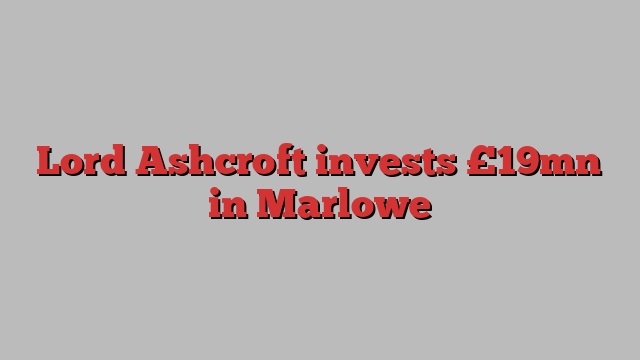
Stay informed with free updates
Simply sign up to the Investments myFT Digest — delivered directly to your inbox.
Lord Michael Ashcroft, former deputy chair of the Conservative party, has bought £18.8mn of shares in business services group Marlowe ahead of a bumper round of dividends and buybacks.
Ashcroft, a non-executive director of the Aim-quoted group, bought 3.42mn shares on May 22 for £5.48 each. He now holds 15.8 per cent of the issued share capital — roughly double that of the biggest institutional shareholder. This hefty purchase coincided with the sale of shares by founder and outgoing chief executive Alex Dacre, who now owns less than 5 per cent of the company.
Analysts at RBC were previously concerned that Dacre’s departure presented some “potential overhang”, but said these transactions reduced the risk.
Ashcroft’s investment looks carefully timed. Marlowe is set to sell its governance, risk and compliance business by the end of this month for an enterprise value of £430mn. It plans to distribute £225mn of this among shareholders by way of a £1.55 special dividend and a £75mn share buyback scheme. This figure is significantly higher than the £150mn originally expected and represents over 40 per cent of the current market capitalisation.
The sale of the governance, risk and compliance assets has eased balance sheet concerns, and cash generation across the group seems to be improving. Having implemented a buy-and-build strategy for the past decade — Marlowe has made around 80 acquisitions since 2015 — management is now focusing on organic growth and “driving margin enhancement” in its compliance service markets. This should lower cash restructuring charges and reduce its level of debt, according to analysts at Panmure Gordon.
Marlowe still awaits the arrival of a permanent chief executive, however, and has yet to implement a “normal” dividend policy.
Petra director bets on shine returning to diamond market
South African miner Petra Diamonds has struggled in recent years with unprofitable mines and weaker rough prices, but every so often a large stone will give it a sales boost and keep the show rolling.
A 14.76 carat blue diamond recovered from the Cullinan Mine in February 2024 should provide a solid boost to sales for the current financial year, ending June 31. Sales of exceptional stones have dropped since 2022, when stones individually worth more than $5mn contributed $89mn (£70mn) to the top line. This dropped to $13mn in 2023. Petra has now increased the definition to $15mn and above for a single diamond.
Overall, its current financial year-to-date sales (up to the most recent cycle reported this month) sit at $329mn. This is ahead of last year, although delayed sales have boosted the current period. The average selling price for the diamonds has dropped from $141 per carat last year to $116 in the current financial year, which ends June 30.
Alongside big stones, Petra needs a strong market to keep the balance sheet in good health, with its debt levels ticking up and broker Peel Hunt forecasting a cash outflow until 2026. To be clear, the company is on surer footing than in 2020, when it largely wiped out retail shareholders to knock down a net debt figure of over $800mn.
But operating profits will probably remain weak without a few more exceptional stones, with Peel Hunt forecasting a $17mn loss this year and a $63mn profit in 2025. Offloading the costly Koffiefontein mine in South Africa should help this, leaving the Cullinan mine in South Africa and reopened Williamson mine in Tanzania as key revenue drivers.
Director José-Manuel Vargas, also the company’s largest individual shareholder with 8.75 per cent, was bullish enough on the diamond market to buy another 1.5mn shares last week. The company declined to comment on the £600,000 purchase.